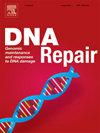用抗癌药物顺铂治疗人类细胞导致caspase依赖性释放含加合物的无细胞DNA
IF 2.7
3区 生物学
Q2 GENETICS & HEREDITY
引用次数: 0
摘要
在生物体液中发现的无细胞DNA (cfDNA)越来越多地被用于各种疾病状态的诊断和治疗,包括癌症。虽然已知DNA容易受到许多不同的化疗化合物和遗传毒性药物的损害,但cfDNA可能受到损害并含有与特定暴露相关的DNA加合物这一事实以前没有得到任何重大的考虑。在这里,使用抗癌药物顺铂处理的细胞培养基的差速离心,我们发现含有顺铂加合物的DNA在细胞外环境中很容易检测到,并且在已知含有小细胞外囊泡和cfDNA的馏分中富集。然而,我们的数据表明,这种受损的cfDNA本质上是非囊泡性的,可能代表染色质片段。剂量和时间过程实验表明,含顺铂- dna加合物的cfDNA的释放与凋亡信号的激活有关。事实上,顺铂损伤的cfDNA的产生会因核苷酸切除修复的缺失而加剧,并被caspase抑制所消除。最后,我们发现天然顺铂损伤的cfDNA,而不是纯化的无蛋白cfDNA,可以被细胞吞噬,导致非顺铂处理细胞中含有顺铂-DNA加合物的DNA的存在。这些结果表明,接受顺铂化疗的患者的肿瘤可能会脱落受损的cfDNA,这可能会在旁观者细胞中产生额外的生物学效应,这可能会影响化疗反应,并导致改善治疗和监测治疗效果的诊断工具。本文章由计算机程序翻译,如有差异,请以英文原文为准。
Treatment of human cells with the anti-cancer drug cisplatin results in the caspase-dependent release of adduct-containing cell-free DNA
Cell-free DNA (cfDNA) found in biofluids is increasingly being used in the diagnosis and treatment of a variety of disease states, including cancer. Though DNA is known to be susceptible to damage by many different chemotherapeutic compounds and genotoxic agents, the fact that cfDNA may be damaged and contain DNA adducts associated with specific exposures has not previously been considered to any significant extent. Here, using differential centrifugation of culture medium from cells treated with the anti-cancer drug cisplatin, we show that DNA containing cisplatin adducts is readily detectable in the extracellular milieu and is enriched in fractions known to contain small extracellular vesicles and cfDNA. However, our data indicates that this damaged cfDNA is non-vesicular in nature and likely represents fragments of chromatin. Dose and time course experiments suggest that the release of cfDNA containing cisplatin-DNA adducts is correlated with the activation of apoptotic signaling. Indeed, the generation of cisplatin-damaged cfDNA is exacerbated by the loss of nucleotide excision repair and is abrogated by caspase inhibition. Finally, we show that native cisplatin-damaged cfDNA, but not purified, protein-free cfDNA, can be taken up by cells by phagocytosis to result in the presence of cisplatin-DNA adduct-containing DNA in non-cisplatin-treated cells. These results indicate that tumors from patients undergoing cisplatin-based chemotherapy may shed damaged cfDNA that could have additional biological effects in bystander cells, which could both impact chemotherapeutic responses and lead to improved treatments and diagnostic tools for monitoring therapeutic efficacy.
求助全文
通过发布文献求助,成功后即可免费获取论文全文。
去求助
来源期刊

DNA Repair
生物-毒理学
CiteScore
7.60
自引率
5.30%
发文量
91
审稿时长
59 days
期刊介绍:
DNA Repair provides a forum for the comprehensive coverage of DNA repair and cellular responses to DNA damage. The journal publishes original observations on genetic, cellular, biochemical, structural and molecular aspects of DNA repair, mutagenesis, cell cycle regulation, apoptosis and other biological responses in cells exposed to genomic insult, as well as their relationship to human disease.
DNA Repair publishes full-length research articles, brief reports on research, and reviews. The journal welcomes articles describing databases, methods and new technologies supporting research on DNA repair and responses to DNA damage. Letters to the Editor, hot topics and classics in DNA repair, historical reflections, book reviews and meeting reports also will be considered for publication.
 求助内容:
求助内容: 应助结果提醒方式:
应助结果提醒方式:


